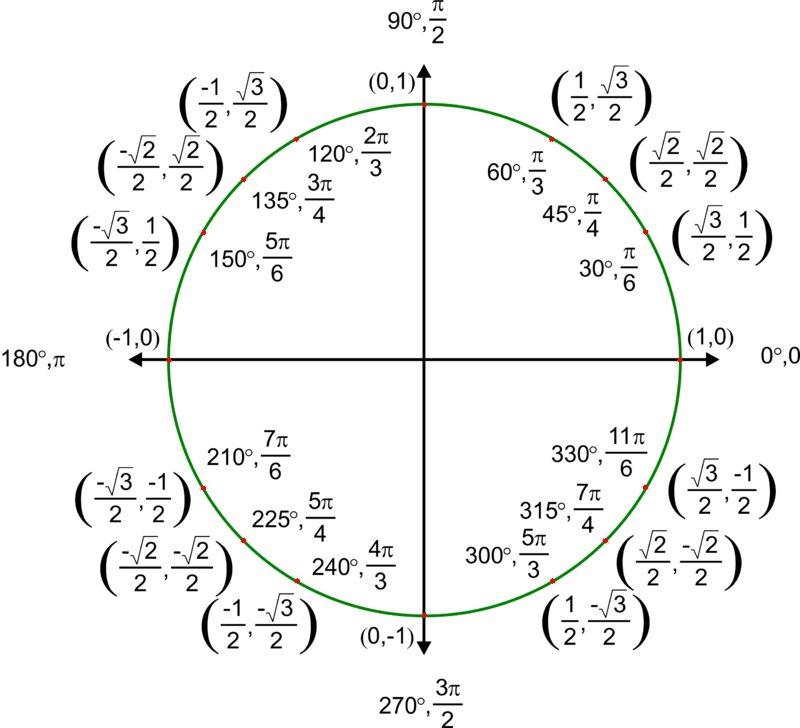Processing math: 100%
Back to the class
Recall the unit circle:
 Section 9.5 #5: Solve on the interval 0≤θ<2π: 2sin(θ)=√3.
Section 9.5 #5: Solve on the interval 0≤θ<2π: 2sin(θ)=√3.
Solution: Isolating sin(θ) in this expression yields sin(θ)=√32. We now look at the unit circle and find all angles whose y-coordinate is √32 and conclude that they are θ=π3 and θ=2π3.
Section 9.5 #9: Solve on the interval 0≤θ<2π: tan(x)=1.
Solution: We must find all angles x on the unit circle whose tangent is 1. This corresponds to the angles x=π4 and x=5π4.
Section 9.5 #14: Solve exactly on [0,2π): 2cos(θ)=−1.
Solution: Isolating cos(θ) in this expression yields cos(θ)=−12. We must find all angles θ whose cosine is −12. The unit circle tells us this occurs at θ=2π3 and θ=4π3.
Section 9.5 #19: Solve exactly on [0,2π): 2cos(3θ)=−√2.
Solution: First isolate cos(3θ) to get cos(3θ)=−√22. Since the argument to cosine is not a single symbol, we introduce a new symbol ψ that is defined by ψ=3θ. This means our equation becomes cos(ψ)=−√22. From the unit circle, we see that the possible values that ψ may take are ψ=3π4 and ψ=5π4. However, this is not a solution to the original equation, because we must solve for θ -- also the fact that the original function had "3θ" means we may end up with more solutions. So recall we want 0≤θ<2pi and we have general solutions
3θ=ψ=3π4+2nπ,n=…,−1,0,1,…
and
3θ=ψ=5pi4+2nπ,n=…,−1,0,1,….
Dividing by 3 yields
{θ=3π12+2nπ3=3π12+8nπ12θ=5π12+2nπ3=5π12+8nπ12.
Now we must find all values for n that yield a θ that is in the range 0≤θ<2π, or in other words, 0≤θ<24π12. First try n=0:
n=0:{θ=3π12+0=3π12✓θ=5π12+0=5π12✓
now try n=−1:
n=−1:{θ=3π12−8π12=−5π12×θ=5π12−8π12=−3π12×
so the rest of the negatives will also fail. Now try n=1:
n=1:{θ=3π12+8π12=11π12✓θ=5π12+8π12=13π12✓
Now try n=2:
n=2:{θ=3π12+16π12=19π12✓θ=5π12+16π12=21π12✓
Now try n=3:
n=3:{θ=3π12+24π12=27π12×θ=5π12+24π12=29π12×.
From the n=3 case we see that all larger n will also fail. Therefore we have found 6 solutions:
θ=3π12,5π12,11π12,13π12,19π12,21π12.
Section 9.5 #23: Find all solutions on [0,2π): sec(x)sin(x)−2sin(x)=0.
Solution: Factor out the common factor sin(x) to get the equation
sin(x)(sec(x)−2)=0.
Using the "zero-product property" (i.e. if ab=0 then a=0 or b=0) we see that this equation boils down to solving two simpler equations: sin(x)=0 and sec(x)−2=0. First let us solve sin(x)=0: from the unit circle we may conclude that the only solutions in [0,2π) are θ=0,π. Now let us solve sec(x)−2=0. First solve for sec(x) by adding 2 to both sides to get sec(x)=2. Recall that sec(x)=1cos(x) and plug that in to get 1cos(x)=2. Take the reciprocal of both sides (i.e. flip both sides upside down) to get cos(x)=12. From the unit circle we see that the solution is x=π3,5π3. Therefore we have found four solutions:
x=0,π,π3,5π3.
Section 9.5 #28: Find all solutions on [0,2π): cos2(θ)=12.
Solution: Taking the square root of both sides (do not forget you must consider both positive and negatives when taking the square root in an equation), we get cos(θ)=±√12. Note that the number √12 is just a different way to write the number √22 because
√12=√1√2=1√2=1√2(√2√2)=√22.
Therefore we must find solutions to cos(θ)=√22 and to cos(θ)=−√22. The unit circle shows us that all such θ are
θ=π4,3π4,5π4,7π4.
Section 9.5 #38: Find all solutions on [0,2π): sin(2t)=cos(t).
Solution: Use the double angle identity for sine on the left to write
2sin(t)cos(t)=cos(t).
Subtract cos(t) from both sides to get
2sin(t)cos(t)−cos(t)=0.
Factor cos(t) out to write
cos(t)(2sin(t)−1)=0.
Now we use the zero-product property to say cos(t)=0 and 2sin(t)−1=0. Solving cos(t)=0 yields t=π2,3π2. Solving 2sin(t)−1=0 for sin(t) yields sin(t)=12 and so we solve that to get t=π6,5π6. Therefore we get the four solutions t=π2,3π2,π6,5π6.
Section 9.5 #94: If a loading ramp is placed next to a truck, at a height of 4 feet, and the ramp is 15 feet long, what angle does the ramp make with the ground?
Solution: First draw the situation:
 Notice that sin relates the two known sides to the unknown angle in the following way:
sin(θ)=415.
Take the inverse sine of both sides to compute
θ=sin−1(415)≈0.2699rad.
An answer in terms of degrees is also ok.
Notice that sin relates the two known sides to the unknown angle in the following way:
sin(θ)=415.
Take the inverse sine of both sides to compute
θ=sin−1(415)≈0.2699rad.
An answer in terms of degrees is also ok.
Section 9.5 #96: A woman is watching a launched rocket currently 11 miles in altitude. If she is standing 4 miles from the launch pad, at what angle is she looking up from horizontal?
Solution: First draw the situation:
 Notice that the tan relates the two sides to θ so we write
tan(θ)=114.
To find the angle θ, take the inverse tangent of both sides to compute
θ=tan−1(114)≈1.222rad.
An answer in terms of degrees is also ok.
Notice that the tan relates the two sides to θ so we write
tan(θ)=114.
To find the angle θ, take the inverse tangent of both sides to compute
θ=tan−1(114)≈1.222rad.
An answer in terms of degrees is also ok.






